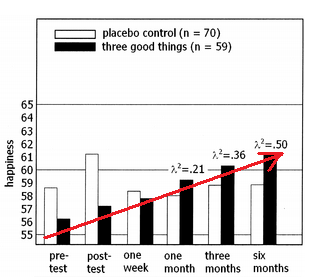There might be affiliate links on this page, which means we get a small commission of anything you buy. As an Amazon Associate we earn from qualifying purchases. Please do your own research before making any online purchase.
Using a sample recruited through the Authentic Happiness website, the authors of the study wanted to compare the effectiveness of five different happiness techniques, each delivered via the internet.
The five techniques chosen were: gratitude visit, three good things in life, you at your best, using signature strengths in a new way, and identifying signature strengths.
The Steen Happiness Index was used to measure changes in happiness, and the Center for Epidemiological Studies-Depression Scale (CES-D) symptom survey for depressive symptoms.
The gratitude visit resulted in an immediate 10% increase in happiness, but the effect was cut in half within one week, and completely gone in six months. Likewise, the visit resulted in a 35% reduction in depressive symptoms, but the effect was cut in half after one month and gone completely in three months.
The using signature strengths exercise resulted in a 5% increase in happiness after one month. The effect was sustained over the next five months. Depressive symptoms declined by approximately 30%.
The other two exercises had no sustained effect.
Three Good Things Exercise Extremely Powerful
“Write down three things that went well each day and their causes every night for one week. In addition, provide a causal explanation for each good thing.”
Participants were asked to follow those exact instructions for just one week.
After one week they were 2% happier than before, but in follow-up tests, their happiness kept on increasing, from 5% at one month, to 9% at six months. All this, even though they were only instructed to journal for one week. Participants enjoyed the exercise so much, that they just kept on doing it on their own.
Depressive symptoms declined by an average of 28% within one week. Depressive symptoms continued to lower for as long as the practice was continued, but only slightly (5%-10% more).
Additional Information
Gratitude Visit: “Participants were given one week to write and then deliver a letter of gratitude in person to someone who had been especially kind to them but had never been properly thanked.”
The Steen Happiness Index used the following questions, with response choices range from a negative (1) to an extreme positive (5):
- Most of the time I am bored.
- Most of the time I am neither bored nor interested in what I am doing.
- Most of the time I am interested in what I am doing.
- Most of the time I am quite interested in what I am doing.
- Most of the time I am fascinated by what I am doing.
Reference
Seligman, M. P., Steen, T. A., Park, N., & Peterson, C. (2005). Positive Psychology Progress. American Psychologist, 60(5), 410-421. doi:10.1037/0003-066X.60.5.410


